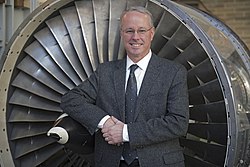David Miller (engineer)
Professor David W. Miller | |
|---|---|
 Dr. Dave Miller posing in front of an airplane engine | |
| Education | Massachusetts Institute of Technology |
| Engineering career | |
| Discipline | Aeronautics & Astronautics |
| Institutions | Massachusetts Institute of Technology NASA |
| Employer(s) | The Aerospace Corporation |
| Projects | SPHERES |
David W. Miller is an American aerospace engineer who is the current Jerome Hunsaker Professor of Aeronautics and Astronautics at Massachusetts Institute of Technology and an elected Fellow of the American Institute of Aeronautics and Astronautics since 2015.[1][2][3][4] He is currently on a leave of absence from MIT to be a VP and the Chief Technology Officer to The Aerospace Corporation.[5] He has worked on multiple NASA projects and served as NASA Chief Technologist.[6]
Early life and education[edit]
Dr. Miller received both undergraduate and graduate degrees in Aeronautical and Astronautical Engineering at MIT.[6]
MIT Professor[edit]
After graduation in 1988, Dr. Miller became a Research Associate for MIT's Aero/Astro. He was promoted to Principal Research Scientist and Assistant Professor before becoming an Associate Professor in 1997.[1][6]
He flew experiments on the Space Shuttle, including STS-48, STS-62, and STS-67 missions.
He is faculty for and the former director of the Space Systems Laboratory (MIT).[7][4] Much of the research has focused on reconfigurable spacecraft concepts and on-orbit operations.[8]
The laboratory has many research projects, include the SPHERES testbed on the International Space Station.[6][9][10][11] The projects have also been on the JWST Product Integrity Team, and the NASA CubeSat Launch Initiative.[8]
He worked with the United States Air Force to create fully funded graduate scholarships for graduates of the USAF Academy's FalconSAT program.[12]
NASA career[edit]
He served as the NASA Chief Technologist from 2014- 2017.[6][13]
He was the principal investigator for the Regolith X-ray Imaging Spectrometer (REXIS) for the OSIRIS-REx asteroid sample return mission, which launched in 2016.[6][14]
He has been an advisor to or on steering committees for a variety of NASA projects:
- Space Infrared Interferometric Telescope (SPIRIT) of GFSC[15]
- In-Space Assembled Telescope (iSAT) Study of JPL[16]
Industry Positions[edit]
Dr. Miller was selected in 2018 to be the vice president and chief technology officer (CTO) of The Aerospace Corporation.[5]
He spent five years on the Air Force Scientific Advisory Board,[8] two of them as the Vice Chair.
References[edit]
- ^ a b "David Miller". mit.edu. Retrieved May 4, 2017.
- ^ "Chief Technologist". mit.edu. Retrieved May 4, 2017.
- ^ "AIAA Fellows Roster" (PDF). AIAA. 2019. Retrieved 20 February 2021.
- ^ a b "AeroAstro's Miller, Lincoln Lab's Evans named AIAA Fellows". MIT News. MIT. 26 January 2015. Retrieved 20 February 2021.
- ^ a b "DR. DAVID MILLER SELECTED AS VP AND CHIEF TECHNOLOGY OFFICER". The Aerospace Corporation. 17 December 2018. Retrieved 20 February 2021.
- ^ a b c d e f "NASA Names David W. Miller as Agency's New Chief Technologist". NASA. 13 March 2014. Retrieved 20 February 2021.
- ^ "MIT's Space Systems Laboratory". MIT. Retrieved 20 February 2021.
- ^ a b c "David Miller Maniac Lecture". NASA Earth Sciences. NASA. Retrieved 20 February 2021.
- ^ "The History of SPHERES". NASA. 22 August 2013. Retrieved 20 February 2021.
- ^ "SPHERES: How a Class Project Turned into an Experiment Facility in Space". Office of Chief Technologist Space Tech. NASA. 18 May 2016. Retrieved 20 February 2021.
- ^ "Space Spheres". Spectrum. MIT. Fall 2004. Retrieved 20 February 2021.
- ^ "Academy, MIT announce new scholarship". USAF Academy. 1 September 2009. Retrieved 20 February 2021.
- ^ "The People of AeroAstro: Professor David Miller". AeroAstro. MIT. Retrieved 20 February 2021.
- ^ "NASA Instrument to Use X-Rays to Map an Asteroid". NASA. 12 July 2016. Retrieved 20 February 2021.
- ^ "The Space Infrared Interferometric Telescope (SPIRIT): A Far-IR Observatory for High-resolution Imaging and Spectroscopy" (PDF). GSFC Astrophysics Science Division (ASD). NASA. 31 March 2009. Retrieved 20 February 2021.
- ^ "In-Space Assembled Telescope (iSAT) Study". Exoplanets. NASA. 28 September 2018. Retrieved 20 February 2021.
